#Circa 510-500 B.C.
Text

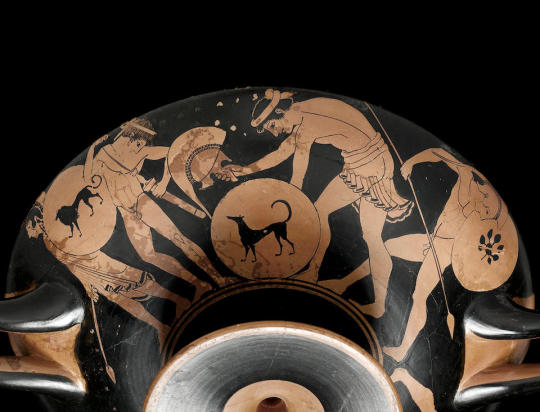


An Attic red-figure 'Kalos' kylix
Circa 510-500 B.C.
#An Attic red-figure 'Kalos' kylix#Circa 510-500 B.C.#pottery#ancient pottery#ancient artifacts#archeology#archeolgst#history#history news#ancient history#ancient culture#ancient civilizations#ancient greece#greek history#greek art#art#ancient art
77 notes
·
View notes
Text


Ancient Greece as depicted in ‘Assassin’s Creed Odyssey ‘
The study of women in ancient Greece has historically been limited and scarce. Although, this situation began to change in the 1990s and with the rise of feminist movements. It was only then that scholars began to explore women who lived alongside men and were part of the ancient Greece society and economy.
There are a number of reasons for this overlook. For instance, some scholars believe that women were not studied because scholars had not thought of them as worth looking for (Morris, 1998, p.193). It is an inevitable fact that men had higher status in ancient Greece as well as more freedom and privileges as citizens than women who were often denied of equal opportunities. This difference in status and restrictions on women meant that women were also less likely to be the subject matter of an artist or craftsman’s object, unless they were goddesses who were important to Greeks’ faith and religious.This inadequate representation of women in general in ancient Greece in addition to limited number of archeological objects that remains today that could be properly analyzed led to this lack of scholarly study of ancient Greek women. Furthermore, some scholars believe that this underrepresentation was intentional.
“Women and slaves remain invisible not because of the inevitable methodological problems with attributing gender and legal status to excavated remains, but because Athenian male citizens wanted it that way.”
(Morris, 1998, p.220)
Regardless, there are still a number of archeological remains that could give us an idea on how women lived in ancient Greece. A great deal of our knowledge on ancient Greece women comes from illustrations done on household object such as vases. These illustration often tell a story or depict a specific scene and by analyzing them scholars are able to understand ancient people.
Below, we will take a look at some of these objects.

Name of object: Women at fountain house
Approximate date of object: ca. 510–500 B.C.
Material of object: Terracotta
Dimensions of object: H. 14 3/4 in. (37.5 cm)
Made in: Attica, Greece
Current Location: The Metropolitan Museum of Art
Significance of the object: This hydria (water jar) depicts a scene where a group of Athenian women are shown to be chatting while filling their hydrias. On the right of the scene, a woman is depicted while she is waiting by the fountain and filling her hydria with water. Behind her, four woman are depicted while they chat with each other. Two of the women are carrying their hydrias on their heads. The other two are using hand gestures while they chat with each other. Providing the daily supply of water was often a woman’s domestic duties in ancient Greece.

Name of object: Hydria with a scene at a fountain-house
Approximate date of object: 520BC-500BC
Material of object: Pottery
Dimensions of object: 50.80 cm
Findspot of object: Vulci, Italy
Made in: Attica, Greece
Current Location: The British Museum
Significance of the object: This hydria depicts a scene in which women are preparing for a ritual while getting water from the fountain-house. There are six women in total in this scene. On the far left and far right we see two women on each side carrying hydrias on their shoulders as they leave the fountain-house. In the centre of the scene we see a pilaster and two Ionic columns, above them a pediment. Behind the pillars, we have two other women drawing water from the fountain shaped like the head of lion, as they pour them into the hydrias. One of the most important role of women in Ancient Greece was preparing for and performing rituals. According to the British Museum, where this hydria is currently on display, the leafy branches that some of the figures in the painting appear to be carrying is often seen in religious contexts suggesting this is a scene from a ritual for the gods Hermes and Dionysos. This ritual known as Hydrophoria, would take place “on the second day of the spring festival of the Anthesteria, and involved the ceremonial pouring of water into a particular chasm.” (The British Museum).
There are a number of household remains that depict women near water fountains. According to The Metropolitan Museum of Art, where the first hydria is on display today, after Peisistratos and his sons changed and improved the water system of the ancient Athens, these type of depictions became more common. These fountains provided an opportunity for women to socialize with each other, update each other on recent events and gossips, and take a break outside from their domestic responsibilities at home.
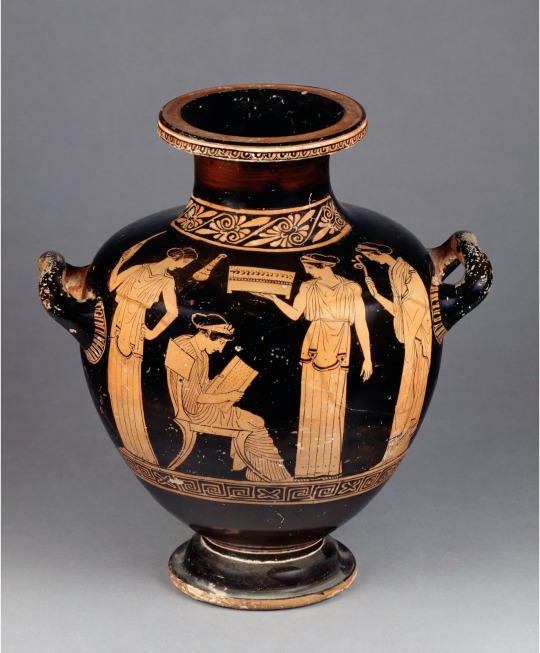
Name of object: Amphora likely depicting Sappho
Approximate date created: 450BC (circa)
Material of object: pottery
Made in: Attica (Greece)
Dimensions of object: 33.02 cm
Type: Hydria
Findspot: Kimissalla
Current Location: The British Museum
Significance of object: This hydria (water jug) depicts four women in a room. One of the women is shown to be seated and is reading a scroll. The three other women appear to be attending her. The attendant on the left is shown to be standing with her left arm on her hip, her gaze down at the seating women, and her right arm holding an object that looks like a spindle flask. The women on the right also have their eyes down at the seating women. One of the women is holding a box and the other is holding what appears to be a flower.
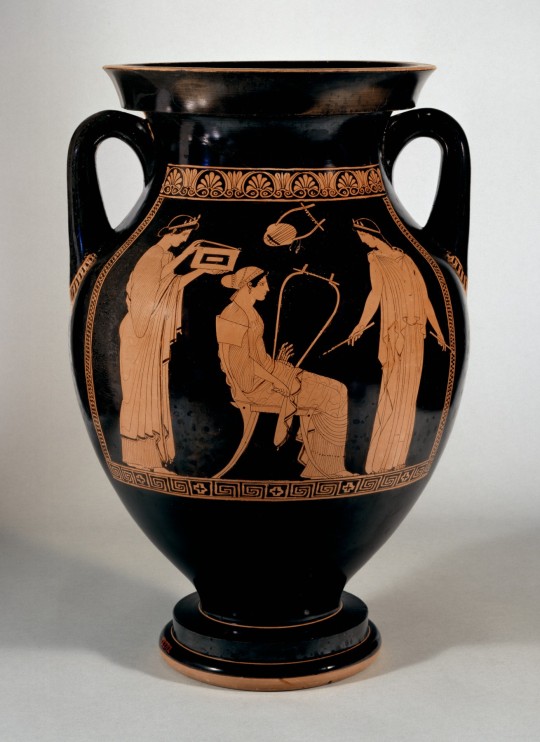
Name of Object: Red-Figure Amphora with Musical Scene
Approximate Date Created: 460-450 BC (Classical Greece)
Material: terracotta
Dimensions: 44.7 cm
Type: amphorae
Object Findspot: Attica, Greece
Current Location: The Walters Art Museum
Significance of object: This amphorae (ancient Greece jar with two handles and a narrow neck) is the work of a prominent painter known as the Niobid Painter (named after his most famous vase). It depicts three affluent Athenian women whom appear to be playing musical instruments. According to the Walter’s Art Museum where this amphorae currently has been placed, the women appear to be wearing the attire of maenads, the female followers of Dionysus' cult (also known as Bacchus). The woman on the right appears to be holding double flutes while the woman in the middle is sitting on a chair and holding a barbiton (a stringed instrument). The third woman on the left appears to be opening a box. On the background we see a lyre (small u-shaped harp used in ancient Greece) hanging above them. This is one of the important pieces of art that remains today and could tell us how the ancient Greece women lived and spent their leisurely times.


Name of Object: Attic Black-Figure Mastos (Side A and B)
Approximate Date Created: 520–500 B.C
Material: terracotta
Dimensions: 12.1 × 20.5 × 13.3 cm
Type: Mastos
Object Findspot: Athens, Greece
Current Location: The J. Paul Getty Museum
Significance of object: The side A of this Mastos (drinking vessel shaped like a women’s breast), depicts a young woman who is playing a double flute. The Side B view, depicts another women dancing while holding a branch and an ivy spring. According to The J. Paul Getty Museum, these attributes as well as their attire which is made of animal skin indicates that they are maenads, female followers of Dionysos (the god of wine). The Mastos were rare type of pottery that were only produced in Athens in the late 500s B.C. and were meant to be used at a symposium (aristocratic male drinking party).Since the nipple did not provide a support for the cup to be put down on the table, the wine had to be consumed all at once.

Name of object: Cup with a Woman Drinking in a Storeroom
Approximate Date Created:460–450 B.C.
Location Created: Athens, Greece
Material of the object: Terracotta
Dimensions: 15.3 × 27.5 × 17.9 cm
Type: Skyphos
Current Location: The J. Paul Getty Museum
Significance of object: This skyphos (a two-handled deep wine-cup) depicts a scene from the daily life of two Athenian women. On the front, an older woman is depicted while she drinks wine from a skyphos. She appears to be out of balance and perhaps drunk. She is unattractive with a misshaped neck. On the left, another younger girl, perhaps a servant, is depicted while she holds a wineskin on her shoulders and carries a jug. According to the J. Paul Getty Museum, where this skyphos is currently on display, aristocratic women in ancient Athens were forbidden from drinking wine and getting drunk as it may have led them to commit adultery or may have harmed their babies. Such bans would have been lifted past child-bearing age. Therefore, this is an unusual piece that remains today which could tell us about these women’s daily lives.
There are a number of vases, jars, cups, and other household objects that depict women playing musical instruments , reading books, drinking wine, or dancing around. These depictions tell us women in ancient Greece did have other hobbies and were involved in a variety of activities besides their domestic duties. Yet, some scholars believe that these portrayals should be treated with cautious because we do not have any testimonies from these women themselves and all we have are illustrations and writings made by men.
“Although some vase paintings depict a rather rosy picture of women reading, playing musical instruments, and dancing that challenge the more conventional view of women as repressed and uneducated, we cannot know how typical such scenes are of daily life.”
(Garland, 2008, p.84)
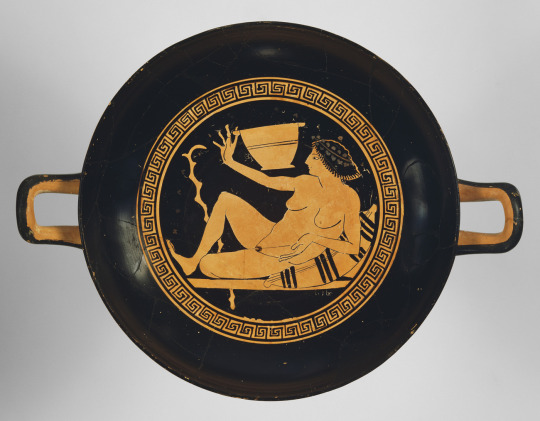
Name of object: Attic Red-Figure Kylix
Approximate Date Created: about 490 B.C
Location Created: Athens, Greece
Material of the object: Terracotta
Dimensions: 8.5 × 36.9 cm
Type: kylix
Current Location: The J. Paul Getty Museum
Significance of the object: This kylix (cup with a shallow bowl and a tall stem), depicts a nude woman lying down on a bed with her left leg bent underneath her right leg. The woman is shown playing kottabos (a drinking game) and she holds a skyphos (drinking cup) with her right hand index finger. According to The J. Paul Getty Museum, since symposiums were events exclusive to men, the women who attended were either hetairai ( a courtesan) or hired prostitutes.
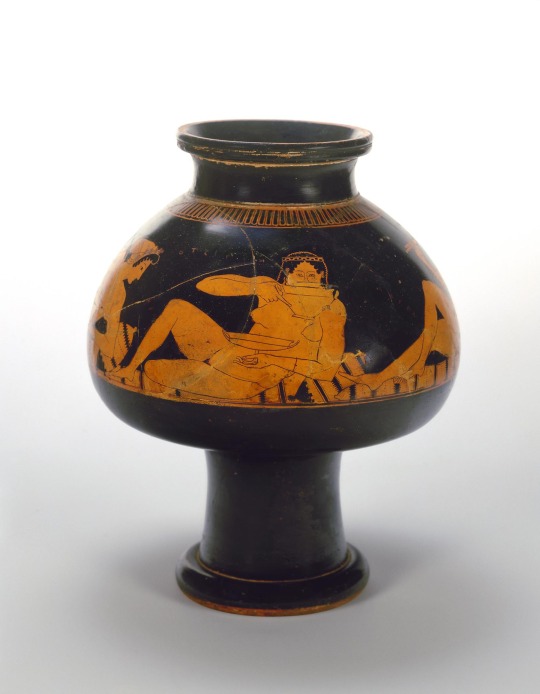
Name of object: Red-figured Psykter: Four Hetaerae
Approximate Date Created: 505-500 B.C.
Location Created: Attica, Greece
Material of the object: Clay
Dimensions: 35.5 cm
Type: Psykter
Current Location: The State Hermitage Museum
Significance of the objet: This Psykter (a vase used as wine cooler), depicts a nude woman who is laying down on a bed and drinking wine. According to The State Hermitage Museum, this vase is the only signed work by Euphronius, a leading Greek vase-painter. On her either side are also two other nude women. Similar to the previous picture, these women are most likely at a symposium and they are either hetaeraes or hired prostitutes for entrainment of men.
In a male dominant society such as ancient Greece where women had many restrictions and limited freedom, depictions of nude women can only mean one thing: they are either courtesans or hired prostitutes. Most of these women are believed to have been slaves or immigrants. In fact, foreign women are almost always discussed as sexual labourers (Kennedy, 2014, p.2). However, remained inscriptions and records indicates that these women also worked as nurses, midwives, woolworkers, musicians, and vendors at markets (Kennedy, 2014, p.3).
“As the Athenians further developed a sense of ethnic and social superiority over the course of the fi fth century, metic women found themselves the victims of a form of ideological warfare. They became the ultimate enemy of the Athenian state and thus found themselves spoken of and represented only as courtesans, concubines, and slaves. But we should not mistake this ideology of the metic woman, this tragic fantasy, for reality. The reality of these women’s lives was probably quite different“
(Kennedy, 2014, p.59)
0 notes